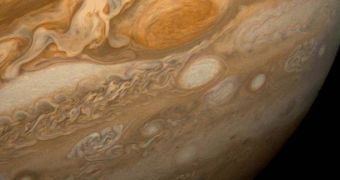The Great Red Spot on the gas giant Jupiter is undoubtedly the largest storm in the solar system, battering the surface of the planet continuously for many centuries. This weather system is very difficult for researchers to see through, but new investigations from a number of ground-based telescopes have recently revealed more insight into how it functions. In fact, the thermal analysis of the formation allowed scientists to create the first-ever map of this formation's interior. Among the most interesting discoveries, the experts include the existence of swirls of warmer air and cooler regions.
With the new research, the team was also capable of peering into the circulation pattern that governs the way this storm functions. It was revealed that the reddest spot in the center of the entire structure is in fact a central area that is considerably colder than the rest of the storm. The thermal images show various dark corridors flowing outwards from the structure, where matter is falling deeper into the planet, mingling with the lower layers of the atmosphere. The new discoveries are already published, in the latest issue of the respected scientific journal Icarus, experts at the NASA Jet Propulsion Laboratory (JPL), in Pasadena, California, announce.
“This is our first detailed look inside the biggest storm of the solar system. We once thought the Great Red Spot was a plain old oval without much structure, but these new results show that it is, in fact, extremely complicated,” says JPL senior research scientist Glenn Orton. He was also one of the authors for the new paper. Also interesting to note is the fact that, while the storm itself has a temperature of about 110 Kelvin (minus 260 degrees Fahrenheit), the reddest areas as they appear in the photos are only 3 to 4 Kelvin (5 to 7 degrees Fahrenheit) warmer than their surroundings. Though the difference may seem insignificant at first, it is more than enough to ensure that circulation occurs.
“This is the first time we can say that there's an intimate link between environmental conditions -- temperature, winds, pressure and composition – and the actual color of the Great Red Spot. Although we can speculate, we still don't know for sure which chemicals or processes are causing that deep red color, but we do know now that it is related to changes in the environmental conditions right in the heart of the storm,” adds former JPL postdoctoral fellow and University of Oxford fellow Leigh Fletcher, who was also the leader of this investigation.
The new datasets were collected using a variety of extremely powerful telescopes. The collaboration included the European Southern Observatory's (ESO) Very Large Telescope (VLT) and the Gemini Observatory, both in Chile, and the Hawaii-based Subaru telescope, which is operated by the National Astronomical Observatory of Japan. Additional information collected in the 1990s by the Galileo spacecraft, as well as data from the 3-meter (10-foot) NASA Infrared Telescope Facility, in Hawaii, were also used for the study.

 14 DAY TRIAL //
14 DAY TRIAL //